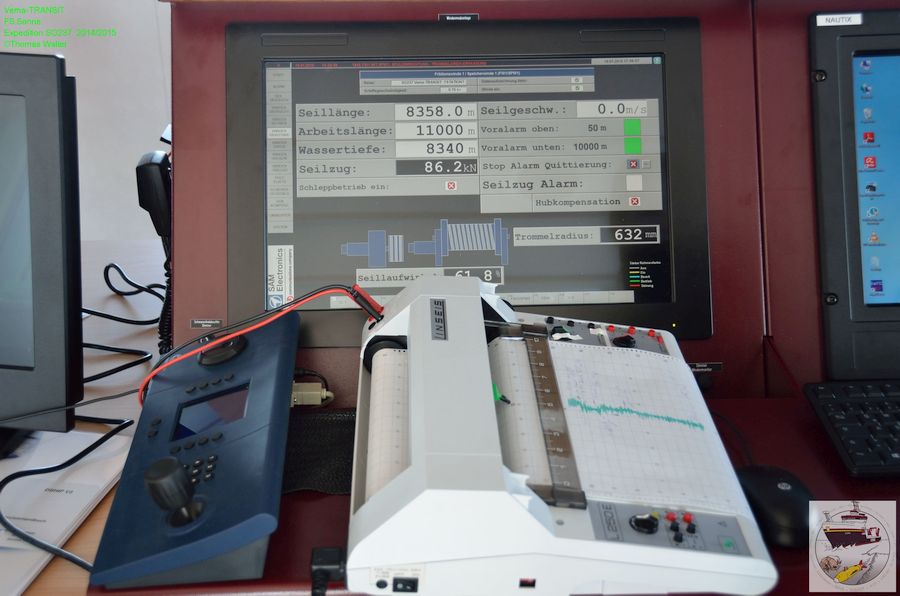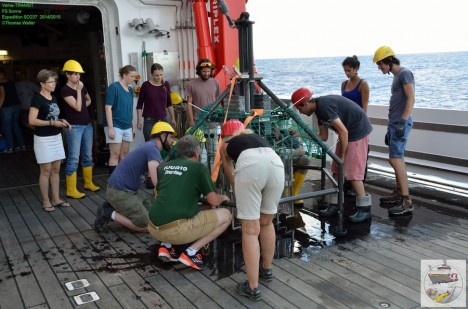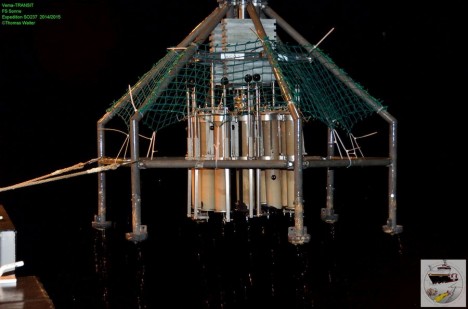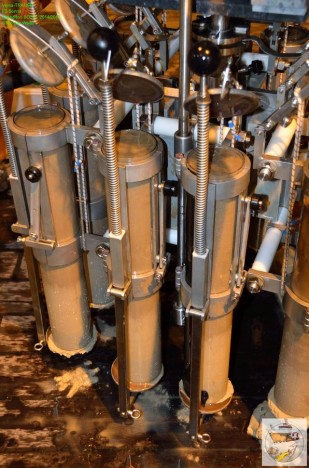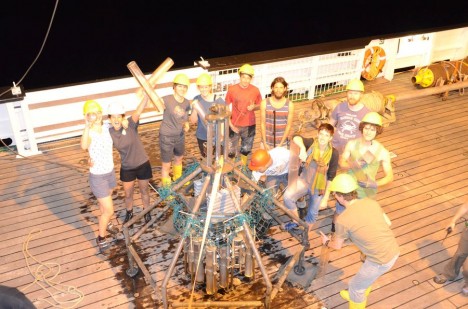„Es ist und bleibt ein Abenteuer die Geheimnisse der Tiefsee zu erforschen. Das MUC-Team (MUC = Multicorer) wartet gespannt darauf, noch nie gesehenes Tiefseesediment aus einem Tiefseegraben mit einer Tiefe von über 8000 Meter an die Oberfläche zu bringen. Die Geheimnisse, die dieses Sediment mit seiner ungewöhnlich cremigen Konsistenz birgt, konnte keiner ahnen. Spannung und Aufregung liegen in der Luft, aber auch Hoffnung, dass das Gerät unversehrt aus der geheimnisvollen Tiefsee zurückkehrt.“
…So ungefähr könnte ein Tiefseethriller der besten Sorte beginnen! Mit ähnlichen Gefühlen begann am 19.01.15 die erste Station in dem Tiefseegraben vor Puerto Rico, beginnend mit dem MUC. Die Vorfreude auf diese Station war bereits ab der Bewilligung, in diesem Gebiet Proben nehmen zu dürfen, täglich gestiegen.
Stellt euch nun vor, ihr steht kurz vor dem Aussetzen eures Gerätes wie z. B dem MUC und wisst, dass er bei 8340 Meter auf dem Boden aufsetzen wird. 50 Meter vorher lasst ihr den MUC auspendeln, fiert etwas langsamer als zuvor weiter und lasst bei Bodenkontakt die Rohre mit einer etwas schnelleren Windengeschwindigkeit in den Boden drücken um anschließend mit einer noch schnelleren Geschwindigkeit das Gerät zu hieven und den MUC mit vollen Rohren sicher an Deck zu bringen. Oder vielleicht beides langsamer, oder doch schneller? Diese Frage stellt sich vor jedem Einsatz und muss jedes Mal, je nach Bodenbeschaffenheit, erneut angepasst werden. Keiner weiß wie genau es an der Stelle aussieht wo das Gerät aufsetzt.
Genau dieses Fahren des Gerätes mit den entsprechenden Angaben und mit einer Portion Feinfühligkeit haben Angelika Brandt und Christina Schmidt gut im Griff.
Der 1. MUC taucht nun unter die Wasseroberfläche und die Vorfreude auf die erste Sedimentprobe steigt mit jedem weiteren zurückgelegten Meter. Und dann! Ganz plötzlich, 100 Meter vor Grund: Die Winde stoppt! Genau jetzt, so knapp vor dem Ziel, nach 3:18 Stunden Wartezeit vor Bodenkontakt. Die Winde wollte uns anscheinend einen Streich spielen. Zum Glück können wir auf eine erfahrene Crew vertrauen, die den MUC mit viel Feingefühl und Geduld – zwar leer, aber heile – wieder an Deck bringen konnte. Als der MUC in voller Montur am Ende des Kabels zu erkennen war konnte man ein leichtes Aufatmen in der versammelten Menschentraube bemerken.
Im Anschluss wurden noch zwei weitere MUC’s gefahren die leider mit nur sehr wenig Sediment gefüllt waren. Das Wasser in den Rohren wurde von der „Protisten-Gruppe“ für ihre Versuche mit Flagellaten entnommen und das wenige Sediment für Christina in den dazu vorbereiteten Gefäßen fixiert. Das an den Rohren klebende Sediment wurde wegen seiner erstaunlich weichen, cremigen, Konsistenz bestaunt und in den Händen verrieben.
Warum waren die MUC`s nicht voll? Es gibt verschiedene Möglichkeiten, wie z. B. durch das schräge Aufkommen auf den Meeresboden (die Rohre auf der einen Seite sind gefüllt, die anderen nicht) oder durch das Aufkommen auf größere Steine oder auf zu hartem Boden (einige Rohre werden aus ihrer Halterung gedrückt und mechanische Bauteile können verdreht sein). Es ist aber auch möglich, dass durch ein starkes Auf- und Abbewegen des Schiffes durch die Wellen der MUC kurz vor oder beim Auslösen über Grund angehoben wird. Viele Faktoren, die nie ausgeschlossen werden können. Und genau das macht das Fahren von Geräten so spannend und lässt einen in vielen Momenten den Atem anhalten – fast wie bei einem Tiefseethriller.
Dieses Gefühl konnte ich selbst als EBS-Schülerin bei Nils Brenke erfahren und kann jetzt verstehen, wie froh die Geräteeinsatzleiter über jede Probe und ein heiles und vor allem vorhandenes Gerät sind.
Der 3. MUC war voll, bis oben hin! Geräteeinsatzleiterin Christina (Kapitän Kirk) konnte dann endlich erleichtert und zufrieden nach einer langen Schicht in ihre Koje klettern. Es wurde bereits beschlossen, dass noch zwei weitere MUC’s gefahren werde sollen. Denn nur mit drei richtig vollen MUC’s können Lidia und Christina, wegen der Vergleichbarkeit der Proben, wissenschaftlich arbeiten.
Es bleibt also spannend, auf derselben Station!
Ich hoffe euch hat der Blog gefallen.
Liebe Grüße im Namen von Kapitän Kirk und dem MUC-Team als Rückenstärkung!
Valeska Borges, Senckenberg am Meer
[English]
„It is and will always be an adventure to discover the secrets of the deep sea. The Multicorer (MUC) team is waiting eagerly to bring never seen deep-sea sediment back to the surface from the deep-sea trench in over 8000sm depth. Nobody could imagine the effects this sediment with its unusual crème-like consistency would have. Restlessness and excitement is in the air, but also the hope that the gear will return unharmed from the secret deep sea.”
… Somehow like this could be the beginning of one of the best deep-sea thrillers! On the 19.1.15 the first station in the Puerto Rico Trench started with similar feelings, starting with MUC deployments. The enthusiasm for this station increase on a daily basis since the permission for sampling this area arrived.
Now imagine you are just ready to deploy your gear, for example the MUC, und you know that it will touch the seafloor in 8350 m. 50 m before ground you let the MUC straighten, you let the cable out slightly slower and when touching the seafloor you increase the speed to push the cores into the ground and then you heave the gear with an even faster speed to close the cores and then to bring the MUC with filled cores safely back on deck. Or is it both with less speed or even faster? This question comes up before every deployment and needs to be adapted depending on the sediment consistency. Nobody knows how the area looks like where the gear will hit.
And exactly this touch for the driving of the gear following the specific notes and a portion of feeling have Angelika Brandt and Christina Schmidt in their hands.
The first MUC dives now down leaving the water’s surface and the excitement about the first sediment sample is raising with every meter gone. But then! Suddenly, 100 meters before the seafloor: the winch stops. Just now, so close to the target, 3:18 hours waiting for the bottom contact. It seems that the winch wanted to play a trick with us. Our luck is that we can trust the experienced crew, who bring the MUC with lots of tender loving care and patience back on deck – empty but complete. When the MUC appeared in one piece at the end of the cable you could hear a slight sigh of relief in the group of people.
Afterwards another two MUC were deployed. Both of them collected unfortunately only too little bit sediment. The water in the cores was sampled by the protest group for their experiments on flagellates and the little bit of sediment was taken by Christina for her with fixative prepared vials. The sediment that was stuck on the outside of the cores was assessed for its soft, crème-like consistency and rubbed into the hands.
Why were the MUCs not filled? There are several possibilities, like an angled touching position on the seafloor (the cores on one side are filled but not on the other) or the presence of large stones on touch or hard sediment (some cores were pushed from their holders and mechanic parts can be bent). It is also possible that through strong up and down movements of the ship caused by waves the MUC was elevated from the seafloor just before or on release of its core mechanism.
Many factors which can never be excluded. And exactly this makes driving the gears so exciting and makes you hold your breath in several moments – like in a deep-sea thriller.
I was able to experiences these feelings myself as EBS-pupil of Nils Brenke (learning how to drive the EBS) and now I understand why the persons deploying the gear are always so relieved about each sample and each intact and especially present gear.
The third MUC then was full, up to the top. Gear deployer Christina (Captain Kirk) was relieved at last and able to climb into her bunk after a long watch. It was already decided that two further MUCs would be deployed. Because three correctly filled MUCs are required for comparability of Lidia’s and Christina’s samples.
It continues to be exciting on the same station.
I hope you liked the Blog entry.
Best wishes in the name of Captain Kirk and the MUC team as back cover!
Valeska Borges, Senckenberg am Meer
(Translation by Kathrin Linse)
